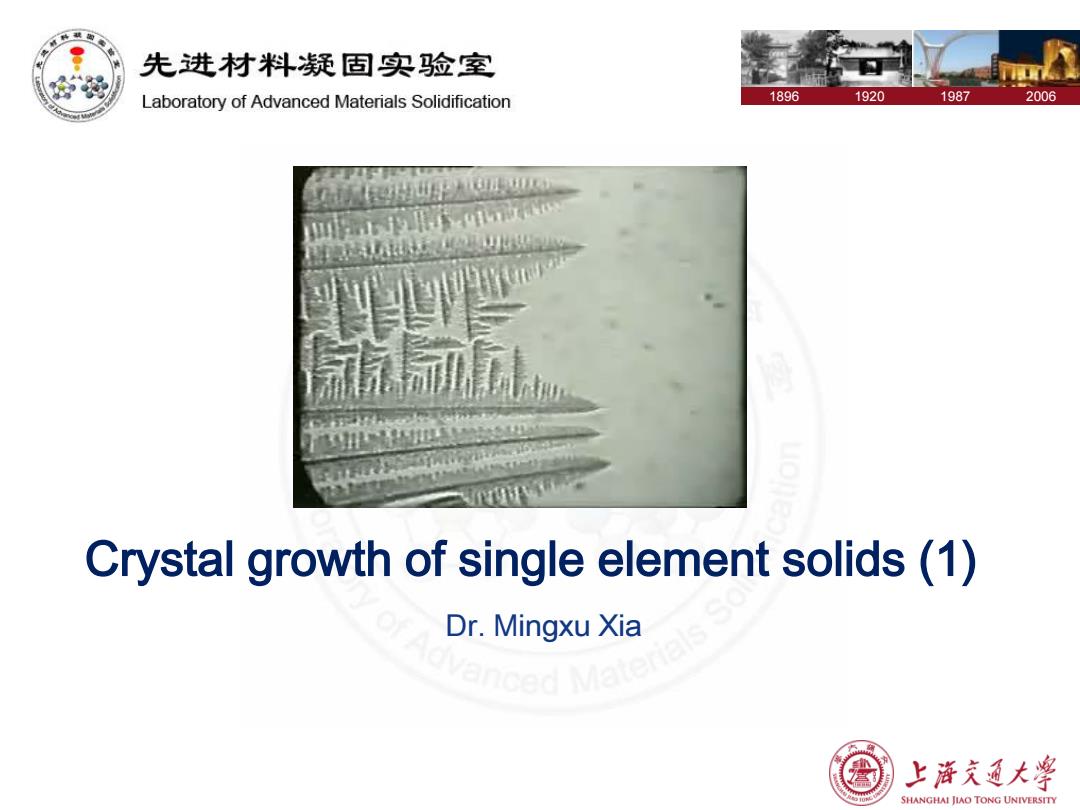
先进材料疑固实验室 Laboratory of Advanced Materials Solidification 1896 1920 1987 2006 Crystal growth of single element solids(1) Dr.Mingxu Xia anced Mat 上浒充通大学 SHANGHAI JIAO TONG UNIVERSITY
1896 1920 1987 2006 Crystal growth of single element solids (1) Dr. Mingxu Xia
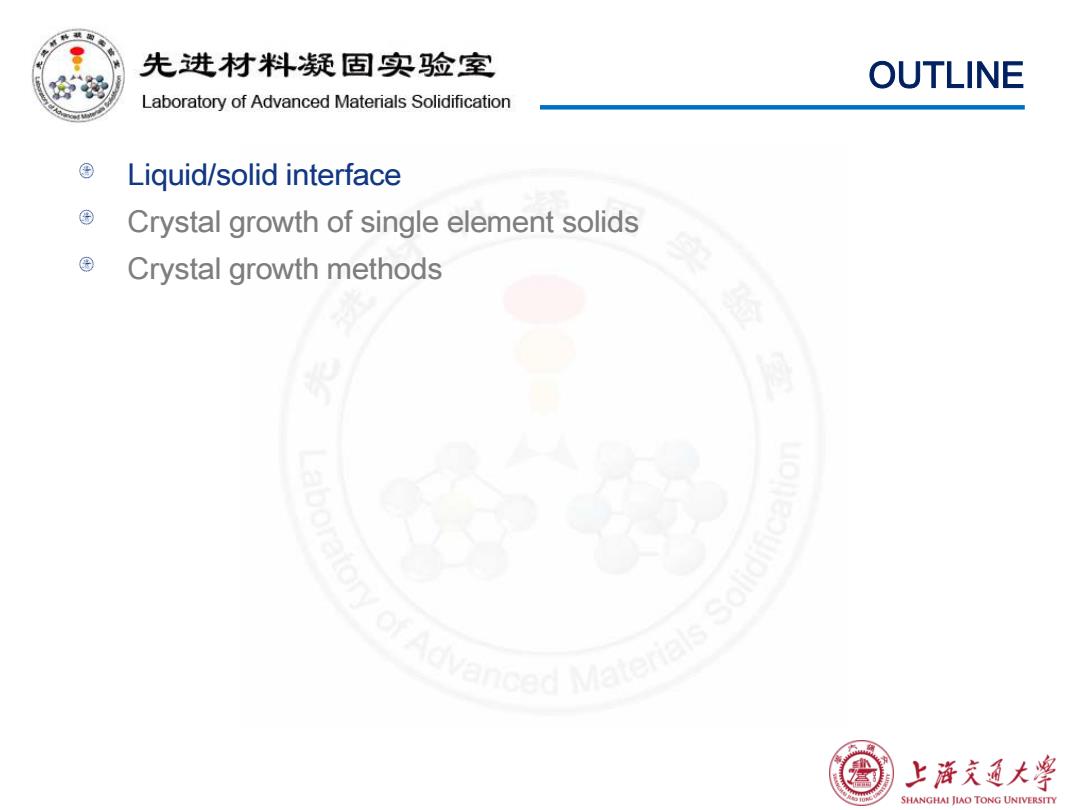
先进材料疑固实验室 OUTLINE Laboratory of Advanced Materials Solidification Liquid/solid interface Crystal growth of single element solids Crystal growth methods A00 上浒充通大学 SHANGHAI JIAO TONG UNIVERSITY
OUTLINE Liquid/solid interface Crystal growth of single element solids Crystal growth methods
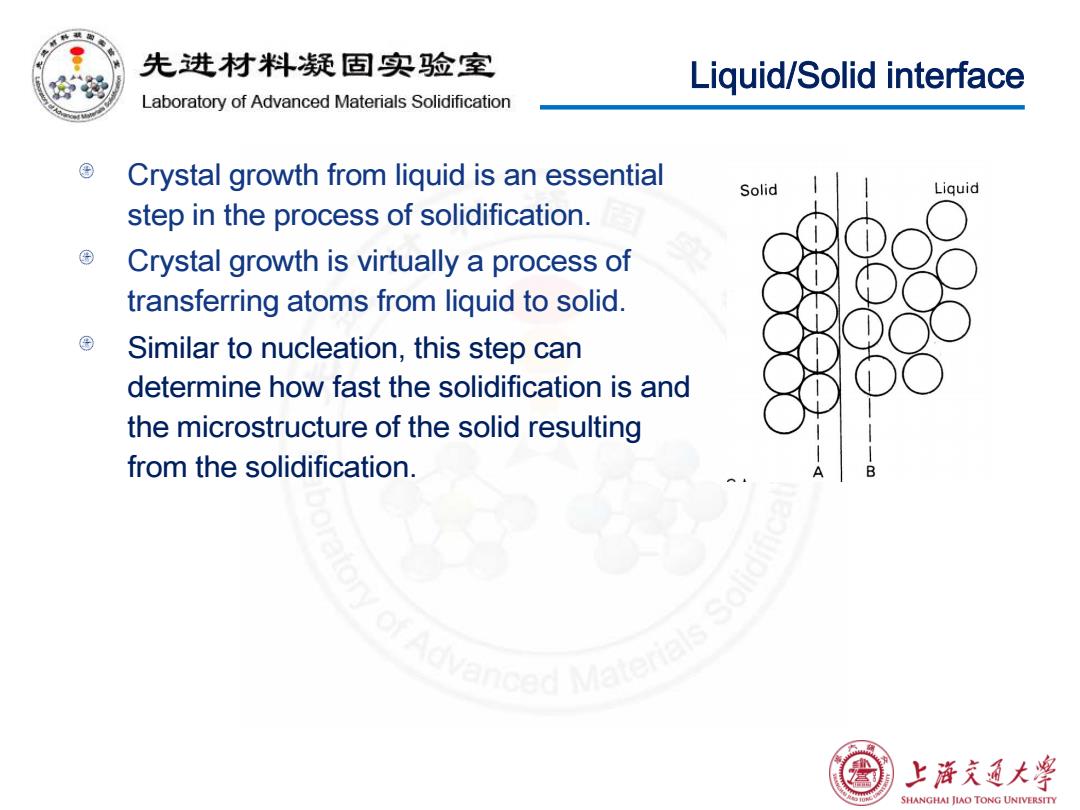
先进材料疑固实验室 Liquid/Solid interface Laboratory of Advanced Materials Solidification Crystal growth from liquid is an essential Solid Liquid step in the process of solidification. Crystal growth is virtually a process of transferring atoms from liquid to solid. Similar to nucleation,this step can determine how fast the solidification is and the microstructure of the solid resulting from the solidification. nced Matere 上浒充通大学 SHANGHAI JIAO TONG UNIVERSITY
Liquid/Solid interface Crystal growth from liquid is an essential step in the process of solidification. Crystal growth is virtually a process of transferring atoms from liquid to solid. Similar to nucleation, this step can determine how fast the solidification is and the microstructure of the solid resulting from the solidification
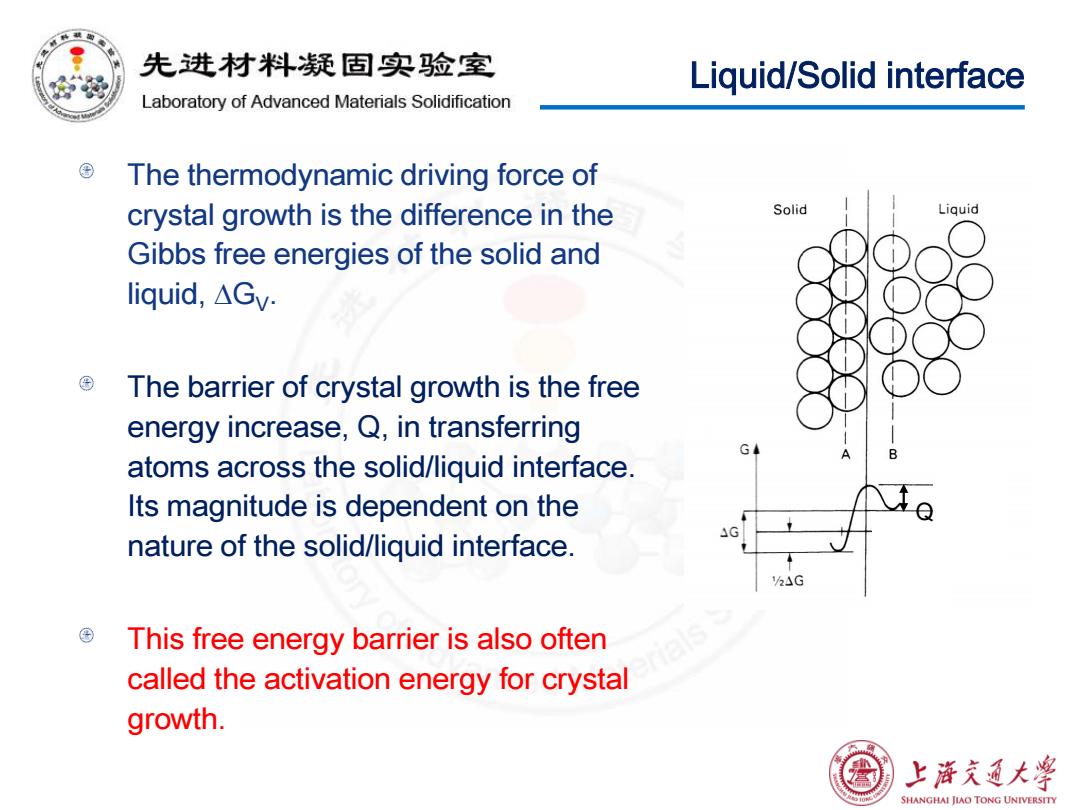
先进材料疑固实验室 Liquid/Solid interface Laboratory of Advanced Materials Solidification The thermodynamic driving force of crystal growth is the difference in the Solid Liquid Gibbs free energies of the solid and liquid,△Gv. The barrier of crystal growth is the free energy increase,Q,in transferring G atoms across the solid/liquid interface. Its magnitude is dependent on the nature of the solid/liquid interface. This free energy barrier is also often called the activation energy for crystal growth. 上浒充通大学 SHANGHAI JIAO TONG UNIVERSITY
Liquid/Solid interface The thermodynamic driving force of crystal growth is the difference in the Gibbs free energies of the solid and liquid, ∆GV. The barrier of crystal growth is the free energy increase, Q, in transferring atoms across the solid/liquid interface. Its magnitude is dependent on the nature of the solid/liquid interface. This free energy barrier is also often called the activation energy for crystal growth. Q
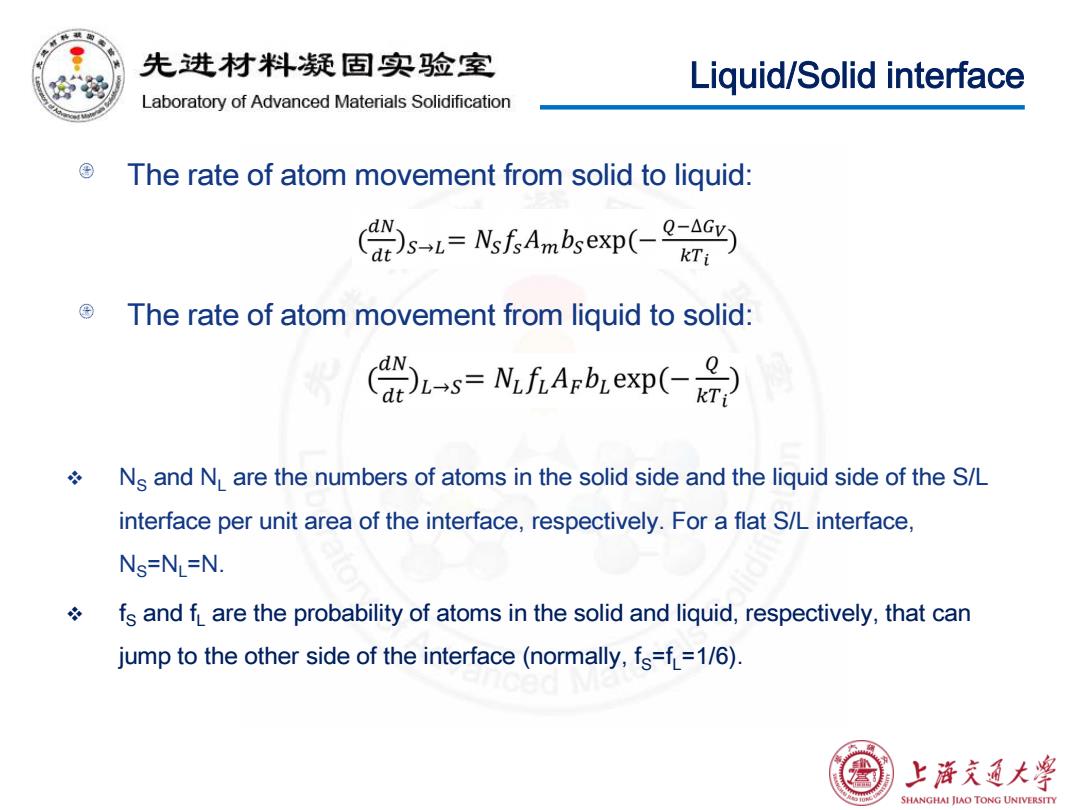
先进材料疑固实验室 Liguid/Solid interface Laboratory of Advanced Materials Solidification The rate of atom movement from solid to liquid: )s-.-NsfAmbsexp(-) The rate of atom movement from liquid to solid: ()L-=Ni.fi.Arbiexp() Ns and N are the numbers of atoms in the solid side and the liquid side of the S/L interface per unit area of the interface,respectively.For a flat S/L interface, Ns=NL=N. fs and fL are the probability of atoms in the solid and liquid,respectively,that can jump to the other side of the interface(normally,fs=f=1/6). 上海充通大¥ SHANGHAI JIAO TONG UNIVERSITY
Liquid/Solid interface The rate of atom movement from solid to liquid: The rate of atom movement from liquid to solid: NS and NL are the numbers of atoms in the solid side and the liquid side of the S/L interface per unit area of the interface, respectively. For a flat S/L interface, NS=NL=N. fS and fL are the probability of atoms in the solid and liquid, respectively, that can jump to the other side of the interface (normally, fS=fL=1/6)
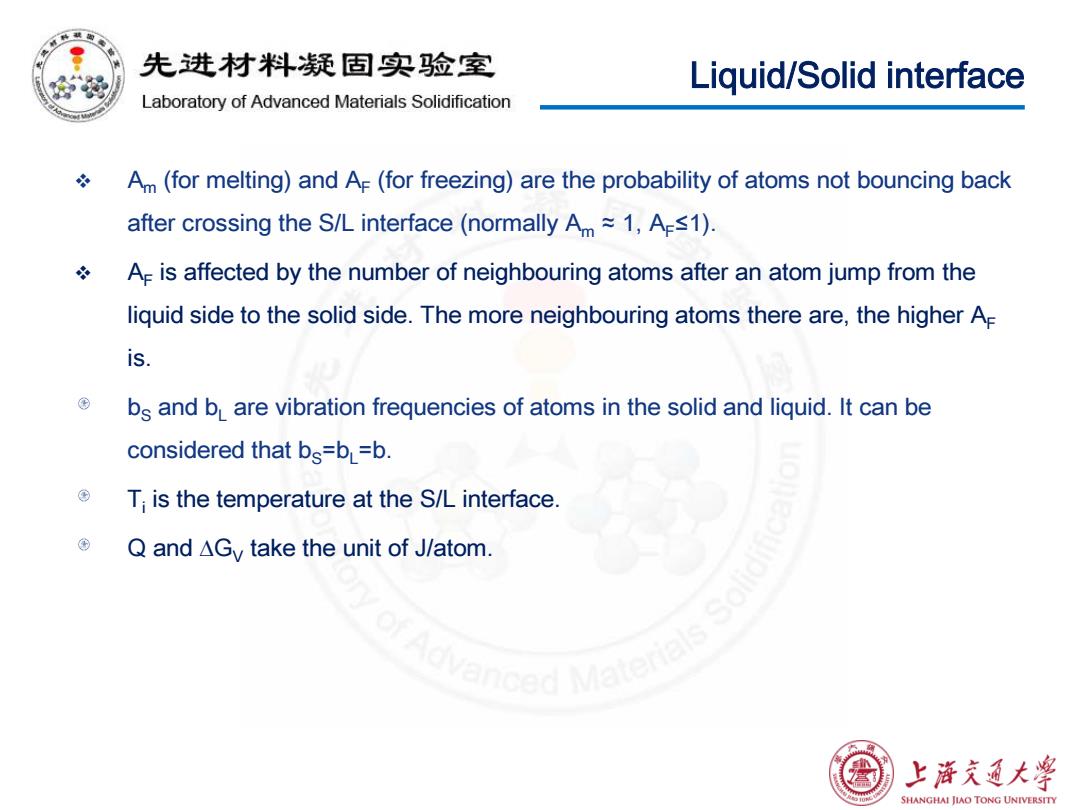
先进材料疑固实验室 Liquid/Solid interface Laboratory of Advanced Materials Solidification Am(for melting)and AF(for freezing)are the probability of atoms not bouncing back after crossing the S/L interface(normally Am≈1,A-≤1). A is affected by the number of neighbouring atoms after an atom jump from the liquid side to the solid side.The more neighbouring atoms there are,the higher Ap is. bs and bL are vibration frequencies of atoms in the solid and liquid.It can be considered that bs=b=b. T;is the temperature at the S/L interface Q and AGy take the unit of J/atom. ed Matenal 上浒充通大学 SHANGHAI JIAO TONG UNIVERSITY
Liquid/Solid interface Am (for melting) and AF (for freezing) are the probability of atoms not bouncing back after crossing the S/L interface (normally Am ≈ 1, AF≤1). AF is affected by the number of neighbouring atoms after an atom jump from the liquid side to the solid side. The more neighbouring atoms there are, the higher AF is. bS and bL are vibration frequencies of atoms in the solid and liquid. It can be considered that bS=bL=b. Ti is the temperature at the S/L interface. Q and ∆GV take the unit of J/atom

先进材料疑固实验室 Liquid/Solid interface Laboratory of Advanced Materials Solidification Only when ()()the crystal can grow and the crystal growth rate,v,is proportional to the difference between the two rates: ).-a)s-L -君ep(品)A4,-em(】 we know,AG=T andso above equation can be rewritten as: 君ap(l-em(色》 上浒充通大学 SHANGHAI JIAO TONG UNIVERSITY
Only when , the crystal can grow and the crystal growth rate, v, is proportional to the difference between the two rates: we know, , and so above equation can be rewritten as: Liquid/Solid interface
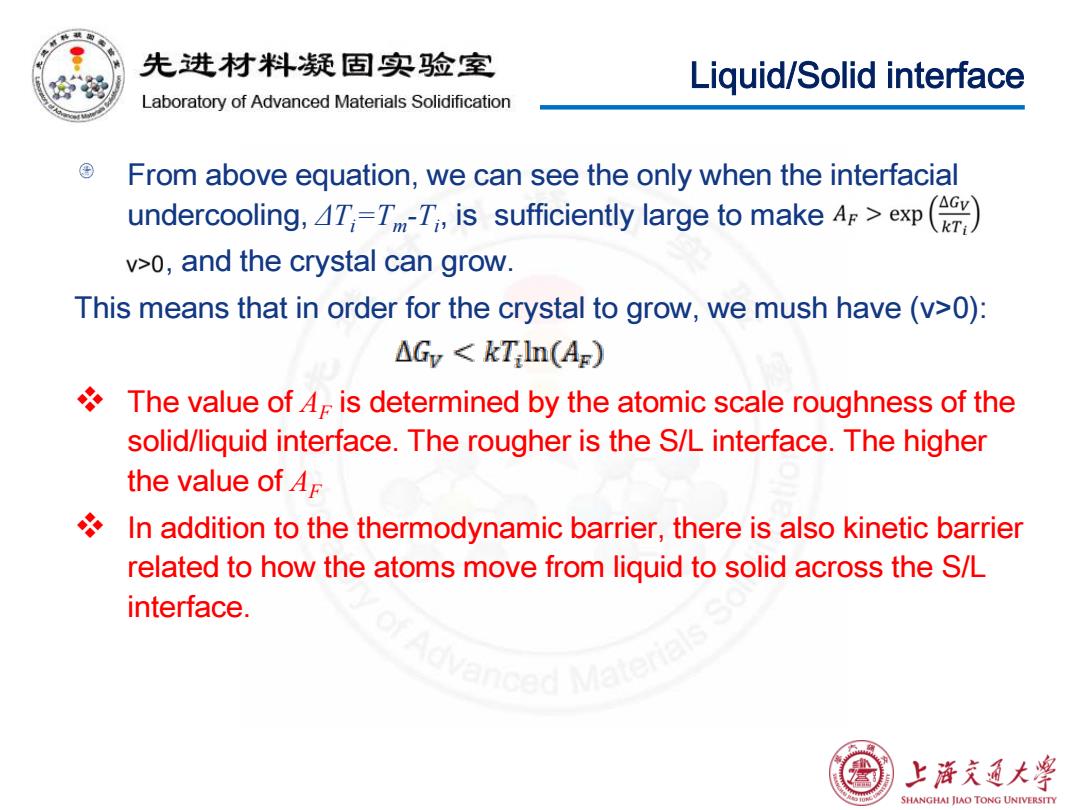
先进材料疑固实验室 Liquid/Solid interface Laboratory of Advanced Materials Solidification From above equation,we can see the only when the interfacial undercooling,,-T-T,,is sufficiently large to make Ar>exp( v>0,and the crystal can grow. This means that in order for the crystal to grow,we mush have (v>0): △Gv<kTln(Ae) The value of 4.is determined by the atomic scale roughness of the solid/liquid interface.The rougher is the S/L interface.The higher the value of 4 In addition to the thermodynamic barrier,there is also kinetic barrier related to how the atoms move from liquid to solid across the S/L interface. 上浒充通大学 SHANGHAI JIAO TONG UNIVERSITY
Liquid/Solid interface From above equation, we can see the only when the interfacial undercooling, ΔTi =Tm-Ti , is sufficiently large to make , and the crystal can grow. This means that in order for the crystal to grow, we mush have (v>0): The value of AF is determined by the atomic scale roughness of the solid/liquid interface. The rougher is the S/L interface. The higher the value of AF In addition to the thermodynamic barrier, there is also kinetic barrier related to how the atoms move from liquid to solid across the S/L interface
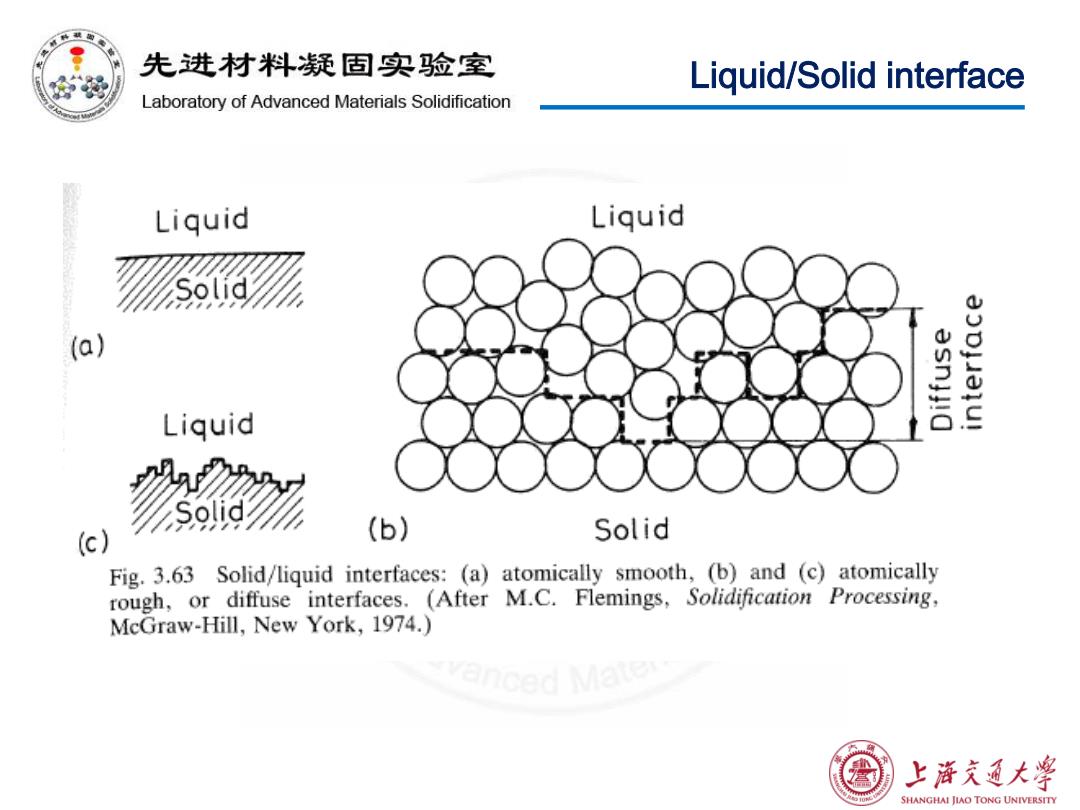
先进材料疑固实验室 Liquid/Solid interface Laboratory of Advanced Materials Solidification Liquid Liquid (a) Liquid 6% (c) (b) Solid Fig.3.63 Solid/liquid interfaces:(a)atomically smooth,(b)and (c)atomically rough,or diffuse interfaces.(After M.C.Flemings,Solidification Processing, McGraw-Hill,New York,1974.) 上浒充通大 SHANGHAI JIAO TONG UNIVERSITY
Liquid/Solid interface

先进材料疑固实验室 Liguid/Solid interface Laboratory of Advanced Materials Solidification (faceted) (nonfaceted) Atomically diffuse S/L interfaces are normally non-faceted,while 10um atomically smooth interfaces are normally faceted. Microscopic level 田 The crystals with atomically diffuse S/L interfaces tend to have rounded morphology,while the crystals with atomically 0.5nm smooth S/L interfaces tend to have faceted morphology. Atomic level sharp rough 上浒充通大学 SHANGHAI JIAO TONG UNIVERSITY
Liquid/Solid interface Atomically diffuse S/L interfaces are normally non-faceted, while atomically smooth interfaces are normally faceted. The crystals with atomically diffuse S/L interfaces tend to have rounded morphology, while the crystals with atomically smooth S/L interfaces tend to have faceted morphology